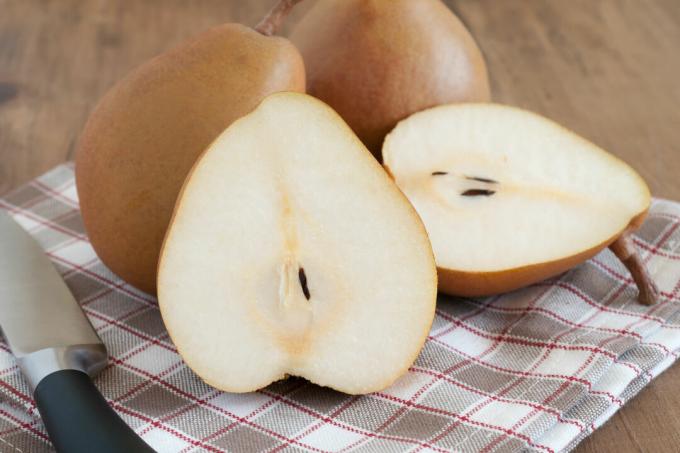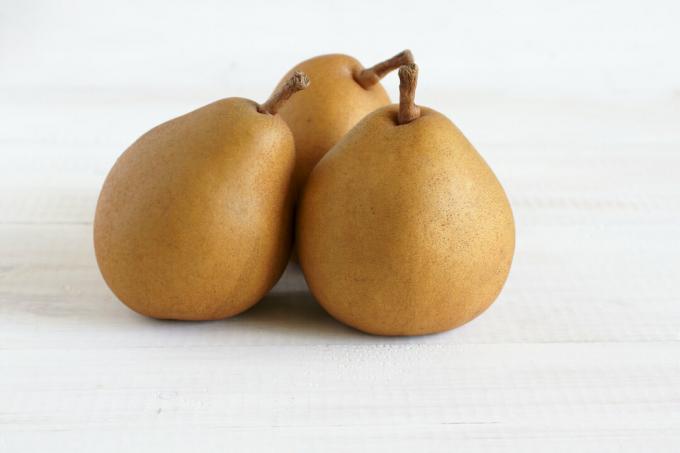‘Gellert's Butter Pear’ is a historic pear variety from France that is still very popular today. The butter pear is a robust variety with delicately melting, aromatic fruits.

Are you looking for a strong pear tree for your garden? Then you have come to the right place with the ‘Gellerts Butterbirne’ variety. We will show you how to properly cultivate the pear variety and what special features characterize the fruit.
contents
- ‘Gellert's butter pear’: profile
- History and origin of the pear variety
- Properties and taste of ‘Gellert's butter pear’
- Tips for growing and caring for ‘Gellerts Butterbirne’
- Harvest and use the type of pear ‘Gellerts Butterbirne‘
‘Gellert's butter pear’: profile
| Synonyms | 'Gellerts', 'Beurré Hardy' |
| fruit | medium to large in size; greenish-ocher-yellow basic color, orange-brown on the sunny side; even russeting |
| taste | juicy, refreshing, fine acidity |
| Yield | rather regularly |
| Harvest time | from the beginning of September |
| Ripe for enjoyment | Mid-September to the end of October |
| Shelf life | bad; storable until the end of October |
| growth | very strong |
| climate | undemanding; windy and dry locations are not well tolerated |
| Diseases and pests | susceptible to scab, viral stone fruit and fruit tree cancer |
History and origin of the pear variety
The culture pear Pyrus communis ˈGellerts Butter Pearˈ is an old pear variety that is very popular. The variety was first discovered around 1820 by M. Bonnet cultivated in France. It soon came onto the market under the name “Beurré Hardy”. This is why ‘Gellert's Butter Pear’ is still sometimes traded under the name ˈ Beurré Hardy ’today. It was only when it was launched in Germany that the variety was given the name Gellerts Butterbirneˈ or just Gellertsˈ.
Properties and taste of ‘Gellert's butter pear’
The fruits of the butter pear are medium to large table pears in a truncated cone shape. The external appearance is characterized by a fine russeting, which usually covers the entire fruit. The skin is rather coarse and rough, which can be annoying when eaten. The basic color of the pears is greenish-ocher yellow. On the sunny side, the fruits develop an orange-brown color. The pulp is yellowish-white, very juicy and melting and refreshing with a fine acidity - it is not for nothing that ‘Gellert's Butterbirne’ is considered one of the best table pears.

Tips for growing and caring for ‘Gellerts Butterbirne’
The ‘Gellerts Butterbirne’ variety shows very strong growth. This property can be moderated a little with a poorly growing base. Nevertheless, the variety is less suitable for trellis growing, but rather good for tall trunks in a spacious garden or on a meadow with orchards. The tree reaches a stature height of well over 5 meters on its own roots or on seedling bases and forms an upright, later laterally overhanging crown.
‘Gellert's butter pear’ can, however, be refined well on quince underlays, so that a greatly reduced growth and an increased yield per tree is achieved. In this way, the pear can also move into smaller gardens. Suitable quince supports are "Quince C", "Quince Sydow" and "Quince A". However, reduced growth can also be achieved with poorly growing pear rootstocks: The rootstock ‘Pyrodwarf’ is particularly worthy of mention here.
Tip: The respective rootstock also has an impact on the properties of the variety: on quince rootstocks, for example, the 'Gellerts' is more susceptible to frost and lime.
"Gellert's Butter Pear" is generally described as a robust variety against diseases, especially wood frost. It is also undemanding as to its location. It does not tolerate windy locations and too shallow or dry soils.
The flowering of ‘Gellert's butter pear’ is early to medium early, but quite tolerant of late frosts. For this reason, the yields do not fluctuate much from year to year - unless provoked by a location that is too poor. Pollen is produced in abundance, which benefits bees and other pear trees nearby. Good pollinators for ‘Gellert's Butterbirne’, on the other hand, are, for example, ‘Bosc’s bottle pear‘,‘ Clapp's darling ’,‘Good Luise'and 'Delicious from Charneux‘.
Due to the very strong growth, it is important that ‘Gellert's Butter Pear’ is cut annually and only cautiously. A radical cut provokes strong growth, lowers yields and ensures fluctuating harvests in the coming years (alternation). However, the upright growing pear can do it especially on weak supports and old, aged trees there is a lack of branches and fruit wood, so that branching should be stimulated by a slightly stronger cut. "Gellert's Butter Pear" is prone to scab, viral stone fruitiness and Fruit tree cancer.
Harvest and use the type of pear ‘Gellerts Butterbirne‘
The delicious fruits of ‘Gellerts Butterbirne’ can be harvested from early to mid-September, if they are still firm. They are ready to eat after one to two weeks, because only post-ripened pears of this variety show their full aroma. All pears should be consumed or processed by the end of October, because 'Gellert's Butter Pear' cannot be stored for long.
In order to extend the storage time of the pears, it is possible to harvest them earlier - i.e. as early as the end of August. This will keep them fresh longer, but have a worse taste. The ‘Gellerts’ can also be used very well for baking or preserving.
One of the most commonly grown pear varieties in Germany is the pear ‘Alexander Lucas‘. In the special article you can find out more about this old variety that offers excellent fruit.
